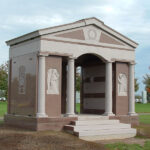The Taj Mahal: A Tomb For Two For Love
- At August 12, 2013
- By mausoleum
- In Doug Keister's Blog
0

We’ve all heard the line before: You’ve gotta go see a certain movie, a tourist site, a cathedral, a … well… insert whatever it may be. What often happens? You see/hear/experience whatever it may be, and you think, “Well that was nice, but it didn’t really knock my socks off.” I think I’d rather hear from someone, “Hey, why don’t you check out (insert item here), I think you might like it.” Then at least my expectations aren’t too high.
However, if you ever get a chance to see the Taj Mahal in person, go! It is truly SPECTACULAR. Not only is it one of the most recognizable buildings in the world, it is also a mausoleum. A tomb built for two.
The Taj Mahal was commissioned by Shah Jahan after the death of his third wife Mumtaz Mahal who died in June, 1631 while giving birth to her fourteenth child. On her deathbed, Mumtaz Mahal asked Shah Jahan to never marry again and to build her a magnificent tomb. Shah Jahan made good on both wishes. The construction of the Taj Mahal mausoleum took sixteen years and was said to have required over 20,000 laborers, sculptors, gem setters, and architects and over 1000 elephants to transport the materials. Construction of the surrounding buildings and grounds that make up the Taj Mahal complex took another five years.
The style of architecture, known as Mughal architecture, is actually a combination of Ottoman Turkish, Indian, Persian, and Islamic architecture. Understandably the Taj Mahal is commonly called the finest example of Mughal architecture in the world.
When you go, plan on spending some serious time exploring the Taj Mahal. There is much to see from the delicate tracery in the stonework to the beautiful gardens. It is a place to be experienced and not merely viewed. If possible, try to go early in the day, not only to capture the early morning light, but to avoid the long lines to view the interior.
Inside the Taj Mahal are the sarcophagi of Shah Jahan and Mumtaz Mahal at the center of the mausoleum. Their bodies, in keeping with Muslim tradition, are actually buried underneath. For the truly adventurous, there are special moonlight viewings of the Taj Mahal on four or five days a month (two days before and two days after the full moon excluding Fridays).
Needless to say, because the Taj Mahal cost an extraordinary amount of money, some people, both then and now, consider it an extravagant waste. But consider the case of Faizul Hasan Kadari, a 77 year old retired postmaster from nearby Lucknow, India about 200 miles east of the Taj Mahal. Kadari is currently building a replica mausoleum of the Taj Mahal for his wife Begum Tajmulli who died in 2011. In an interview in May, 2013, he told London’s Mail Today, “I used to think that Shah Jahan insulted the common man by building a magnificent monument to love. But after the death of my wife in December, 2011, I realized that it had more [to do] about the intensity of love than the money.”
Text and copy © Douglas Keister Visit Doug’s Author Page
